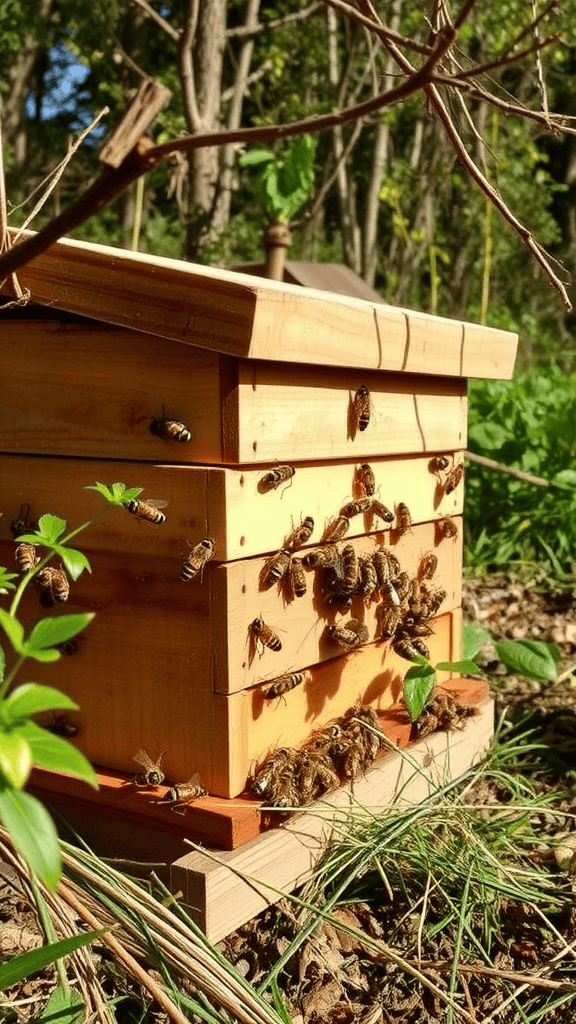Step-by-Step Guide to Making a Beehive at Home
If you’ve ever thought about making a beehive at home, you’re in for an exciting journey! Building a beehive isn’t just a fun DIY project; it also helps support local bee populations. Here’s a simple step-by-step guide to making your very own beehive at home.
Gather Your Materials
Before you start building your beehive, you’ll need to gather the right materials. Here’s a list to help you get started:
- Wood (pine or cedar is ideal)
- Wood screws or nails
- Beehive plans or blueprint
- Wood glue (optional, but helpful)
- Paint or wood finish (non-toxic)
- Protective gear (gloves, goggles, veil)
- Bee frames and foundation (you can buy these online or from a local supply store)
Choose Your Beehive Design
There are various types of beehives, like the Langstroth, Top Bar, and Warre hives. The Langstroth is the most commonly used design and is great for beginners. Find a plan that suits your skill level and budget. Once you have your plan, it’s time to cut your wood according to the measurements provided. A circular saw usually works well for this task.
Construct the Hive Body
The hive body is where your bees will live and work. Follow these steps:
- Make the bottom board: Cut a piece of wood to serve as the base. This piece will support the whole hive. Make sure to create a few entrance holes for the bees.
- Create the walls: Cut four pieces of wood for the sides, ensuring that they are the same height. Assemble these pieces to form a rectangle, attaching them to the bottom board using screws or nails.
- Add the top cover: Cut a piece for the top that extends over the edges to protect the hive from rain. Secure it in place.
Build the Frames
The frames will hold the honeycomb structure where bees will store honey and pollen. Here’s how to make them:
- Cut wooden strips to the correct size for your hive.
- Create a rectangle using these strips and fasten them with nails or screws.
- Attach a wax foundation to each frame. This foundation guides bees in building their honeycomb.
Assemble the Beehive
Once the body and frames are built, it’s time to put everything together:
- Place the frames inside the hive body, leaving space between them for bees to work.
- Fit the top cover snugly on the hive.
- Paint or finish the hive with a non-toxic sealant to protect the wood.
Location, Location, Location
Choosing the right spot for your beehive is crucial. Pick a location that has sun exposure in the morning but is shaded during the hottest part of the day. Make sure the area is sheltered from strong winds. Additionally, ensure there are flowers nearby for the bees to forage.
Introduce Your Bees
After building your beehive, it’s time to introduce bees. You can purchase a bee package or a nucleus colony and transfer them to your hive. Make sure to follow the instructions provided with your bees for a smooth introduction.
Maintain Your Beehive
Regular maintenance is key to successful beekeeping. Check your hive every few weeks to monitor bee health, ensure there’s enough food, and manage pests. During harvesting season, you can begin to collect honey!
Building a beehive at home can be a rewarding experience that allows you to contribute to environmental health while enjoying the sweet rewards of honey. By following this step-by-step guide, you’re well on your way to enjoying your homemade beehive. Happy beekeeping!
Essential Tools and Materials for DIY Beehive Construction
Building your own beehive can be an enjoyable and rewarding project for any aspiring beekeeper. Before you start assembling your hive, you’ll need to gather essential tools and materials that will make the process smoother and more efficient. Let’s break down what you need to successfully construct a DIY beehive.
Wood for the Hive
The primary structure of your beehive will be made from wood. Opt for untreated pine or cedar, as these materials are naturally resistant to decay. A standard Langstroth hive is a popular choice among beekeepers and consists of multiple boxes where bees live and store honey. Here are the wood components you’ll need:
- Hive bodies (deeps or mediums)
- Hive covers (also called roofs)
- Bottom boards
- Inner covers
Crafting Tools
To turn your plans into reality, you’ll need a few basic woodworking tools:
- Table saw: Ideal for making precise cuts in your wood.
- Drill: Necessary for making holes for screws and attaching parts together.
- Screwdriver: A basic tool to fasten screws into place.
- Measuring tape: Important for achieving accurate dimensions.
- Square: This ensures your corners are perfectly aligned.
- Sander: For smoothing out rough edges and surfaces.
Joining Materials
To hold your beehive together securely, you’ll need some joining materials:
- Screws: These will provide a strong connection between the different parts of your hive.
- Wood glue: For added stability, applying wood glue can reinforce your hive joints.
- Wood plugs: If you want to hide screw heads, wood plugs can give your finished hive a neat appearance.
Bee Space Tools
Maintaining the right “bee space” is crucial to hive construction. This refers to the proper distance between parts that allows bees to move freely. There are tools available to ensure this distance is maintained:
- Bee space gauge: A simple tool that helps you measure the ideal gaps.
- Spacers: These can be added between frames to help with bee passage.
Protective Gear
While crafting your beehive, it’s wise to prioritize safety with the right protective gear:
- Bee suit: A full-body suit to protect against stings.
- Gloves: Long gloves will keep your hands safe while you work.
- Veil: A mesh veil will protect your face and neck from angry bees.
Finishing Supplies
After constructing your beehive, you’ll want to protect it from the elements. Here are some finishing supplies:
- Wood sealer: This will help extend the life of your wood by providing a waterproof barrier.
- Non-toxic paint or stain: If you choose to add color, opt for a non-toxic formula that is safe for bees.
Hive Frames and Foundation
Don’t forget the frames that will hold the beeswax or plastic foundation. Each frame should be strong enough to hold the honeycomb:
- Frames: Standard frames come in different sizes, so be sure to choose the ones that match your hive.
- Foundation sheets: These are either wax or plastic and provide a base for bees to build their comb.
By gathering these essential tools and materials, you can construct a DIY beehive that will serve as a safe home for your bees. Not only will you enjoy the satisfaction of crafting your own hive, but you’ll also be well on your way to becoming a successful beekeeper. Happy building!
Conclusion
Creating a beehive at home is an exciting and rewarding project that allows you to support local bee populations while enjoying the sweet rewards of honey production. By following the step-by-step guide provided, you have learned how to construct a beehive that suits your specific needs.
Remember, gathering the right tools and materials is crucial for successful beehive construction. Whether you choose to build a top-bar hive, a Langstroth hive, or a Warré hive, ensure that you have all the necessary components. Quality wood, beeswax foundation, and appropriate tools like a saw, drill, and hammer will make the difference between a sturdy hive and one that may fall short.
As you embark on this journey, keep in mind the importance of maintaining your beehive. Regular inspections will not only help you monitor the health of your bees but also ensure that your beehive remains in good condition. Engaging with local beekeeping communities can be immensely beneficial for newcomers; their valuable experience and insight can guide you through any challenges you may face.
So, gather your materials, get creative, and enjoy the process of building your beehive. Watching your bees thrive in a space you’ve created will bring you immeasurable joy. Plus, you’ll be playing a vital role in the ecosystem by helping to support the important work that bees do. Happy beekeeping, and may your hive flourish!
As an Amazon Associate, I earn from qualifying purchases.

